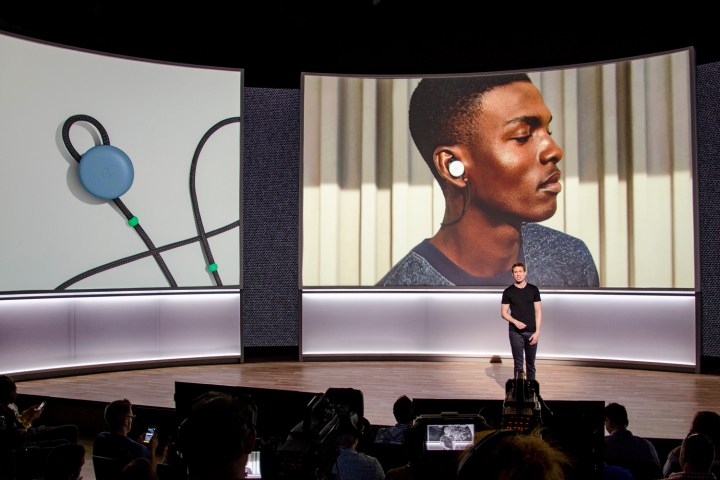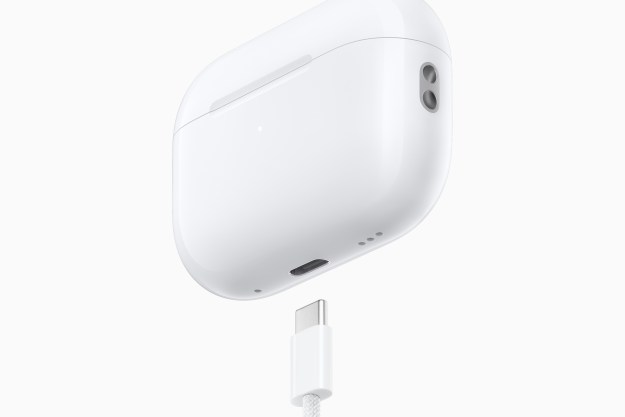
When rumors began swirling about Google’s Pixel Buds ahead of Google I/O last fall, there was excitement in the air. Apple’s AirPods had been dominating the fully wireless market for months, and it was assumed Google’s first try at headphones (wired or wireless) would be Alphabet’s answer to Apple’s coup.
Unfortunately, when Pixel Buds arrived, you could feel the air get sucked out of the room. Not only were the bulbous buds not fully wireless, but strange design traits like an odd fit and a braided connection cable that clumsily winds around the inside of the charging case put almost everyone off Google’s latest hardware. This wasn’t a Fire Phone-level disaster, but even our 3-star rating seems somewhat generous in hindsight.
Google obviously wanted to make its first headphones totally wireless, but couldn’t.
As such, the recent rumor about Google’s plan for the Pixel Buds’ second generation — expected next fall — might seem surprising, but it’s really not. If Google wants to play with Apple and the other big boys in hardware, it must cement its place in the headphone lexicon. That’s doubly true since the company followed Apple in cutting the headphone jack from its Pixel 2 phone; otherwise Google is essentially throwing millions out the window.
So, we’re doing our civic sonic duty to help Google learn from its early stumbles. Here are five things Google has to do to make the
Go fully wireless
This is an obvious one given the competition, though also a somewhat awkward assertion given this writer’s history in calling out true wireless earbuds’ troubled past (and present, really). That said, new technology advancements such as improved Near Field Magnetic Induction (which connects earbuds through your skull) — as well as coming advancements in Bluetooth — have made it easier than ever to go wire-free.
Further, the fact that Google put all its battery tech, hardware, and controls inside the big black buds themselves — instead of in the cable like so many other wireless earbuds — means Google obviously wanted to make its first
Battle the bulge, fix the fit
Two of the biggest complaints about the Pixel Buds were the sheer enormity of their exterior and the fit, which rested them just outside the ear canal instead of snuggly within. The entire design has to trim down and shape up. The earbuds need to be lighter and fit better for one of the most common use cases in wireless headphone land: Your daily workout.
The
It may not be easy, but the next Pixel Buds must be more comfortable and versatile. If Google wants to beat Apple at its own game, it has to make a product that is more at home in the gym than the golf tee-shaped AirPods.
Be the best at battery life
Battery life is one of the biggest issues with

Google’s original Pixel Buds battery just matched the AirPods — even though the PBs weren’t fully wireless — and that’s just not good enough. You can bet Apple’s AirPods 2 will offer at least a modest boost in battery life, and if Google wants to make any waves, the
Better sound, fancier features
The Pixel Buds’ audio performance is … fine. The bass-heavy sound signature isn’t our favorite, but it likely appeals to a wide swath of potential users. We honestly don’t expect Google to do much here, but we’d love to see at least a modest improvement in clarity and detail for the midrange and treble. Google’s Max and Mini wireless speakers hold their own in their respective markets, and the Pixel Buds would do well to up their game here.
As for features, while the Pixel Buds’ easy access to Google Translate and responsive touch controls impressed, we’d love to see such basic features as track skip added to the package. While we’re at it, how about an accelerometer to pause playback when the earbuds aren’t in your ear? Once again, this is a necessity to catch Apple’s AirPods.
Get on the case
Finally, as noted above, a charging case is a big part of the true wireless experience, and while the original Pixel Buds’ little grey case was ok, Google can do better. The case’s top flap always felt flimsy to us (and others) and further, the little pegs and spacious interior made for quite a bulge in our pocket (and no, we’re not just happy to see you).
While this writer is among the first to fault Apple for cutting features just to slim down (cough, headphone jack), the AirPods’ case is second to none when it comes to sleek design, slim size, and functional tech. It fits perfectly in any pocket, the little cap is easy to open with just one hand, and the earpieces pop up like little tulips when opened, ready to play – it even prompts an iPhone with battery level info for both the buds and the case. While such a design wouldn’t work for today’s Pixel Buds, borrowing a page from the AirPod book with a slimmed down case and better charging should be a hallmark for the Pixel Buds of tomorrow.
Conclusion
There is, of course, much more Google could do to make the
It’s on you now, Google. To quote one Judge Smails from Caddyshack: “We’re waiting!”
Editors' Recommendations
- AirPods 4: Everything we know about Apple’s next wireless earbuds
- Apple lets AirPods Pro owners upgrade to USB-C
- New AirPods teased for 2024, to little surprise
- When it comes to charging AirPods Pro with USB-C, don’t overthink it
- Apple has upgraded the AirPods Pro with lossless audio, sort of






